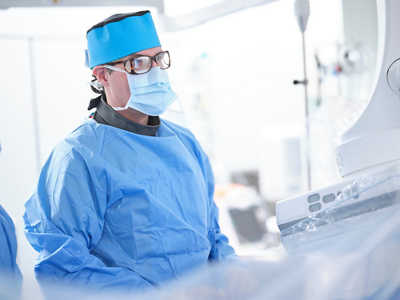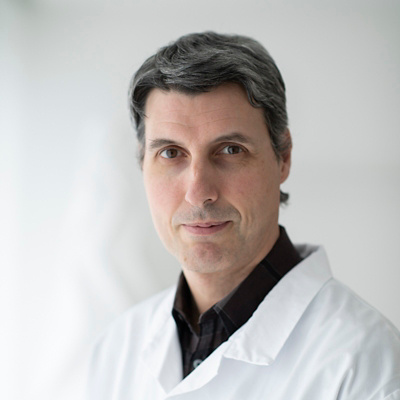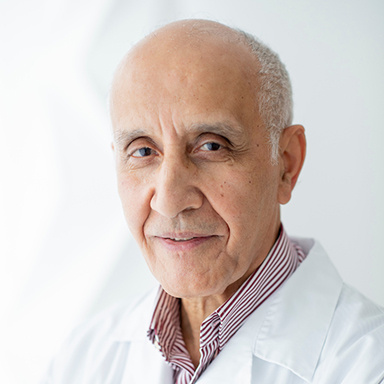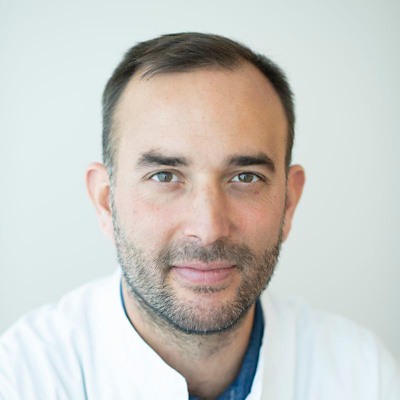Angiology is a branch of medicine that focuses on peripheral vessels, which are the arteries that carry oxygen-rich blood to organs and veins that bring oxygen-poor blood back to the heart.
Each of these vessels is essential for the proper functioning of the human body and can be affected by different pathologies.
The vascular center of the Clinique des Grangettes is able to provide multidisciplinary care for patients with venous and arterial diseases.
Thanks to our two catheterization rooms, the center offers adapted and often minimally invasive treatments using endovascular techniques, allowing to take care of the various pathologies of the vessels. When the disease is too large to be treated endovascularly, the patient is treated surgically in the operating room.
Arterial diseases of the lower limbs
Arterial diseases are grouped into two main entities:
- Obstructive disease
- Aneurysmal disease (dilated artery)
Obstructive disease of the lower limbs
The obstruction of the arteries of the lower limbs causes pain when walking, typically in the calves, thighs or buttocks (vascular claudication). These pains force the patient to stop after a few meters and then, after a break, he can start again for a few meters again. Revascularization of the arteries may be proposed. It can be done in two different ways:
• Balloon expansion, with or without stent placement (small metal spring).
• Vascular bypass surgery
Aneurysms
Aneurysms or dilations of the arteries mainly affect the abdominal aorta and popliteal (knee) arteries.
The risk of abdominal aneurysm is mainly rupture and it is therefore treated, preventively, when it reaches a certain size. Today the treatment is mainly done endovascular and requires only two to three days of hospitalization. Sometimes surgical treatment is necessary which involves hospitalization and longer convalescence.
The popliteal aneurysm, on the other hand, presents a risk of acute occlusion in the arteries of the legs. It is treated preventively by surgical bypass, the results of endovascular stent treatment not being satisfactory in this situation. In patients considered too fragile to withstand bypass surgery, endovascular treatment can still be discussed.
Venous diseases
Venous involvement comes in two main forms :
- Varicose veins
- Venous thromboembolic diseases (thrombosis and/or pulmonary embolism)
Varicose veins
Primary varicose veins are very common and often hereditary. A venous examination performed by a specialist is necessary to establish a diagnosis. Indeed, if skin varicose veins are superficial and often visible to the naked eye, internal varicose veins are only noticeable by ultrasound. In addition to their sometimes unsightly nature, varicose veins are often responsible for symptoms such as pain, heavy legs, itchy legs, swollen legs or, in advanced stages, pigmentation or skin ulcers.
Surgical treatment of varicose veins is less and less prescribed. Instead, doctors choose to refer patients to heat, laser or radiofrequency treatments. Because they consist of burning the varicose vein from the inside without leaving an external scar, they represent a less invasive but equally effective alternative. They can be performed on an outpatient basis, with simple local anesthesia. For heavier cases, however, deep sedation such as hypnosedation or general anesthesia and one night of hospitalization may be necessary.
Venous thrombosis
Venous thrombosis is a medical emergency, caused by the formation of a clot in the bloodstream. It can have serious consequences on venous circulation, cause a venous ulcer, or, if it migrates and obstructs the pulmonary artery, create a pulmonary embolism.
In most cases, treatment involves thinning the blood using oral anticoagulants. Only serious situations require hospitalization.









